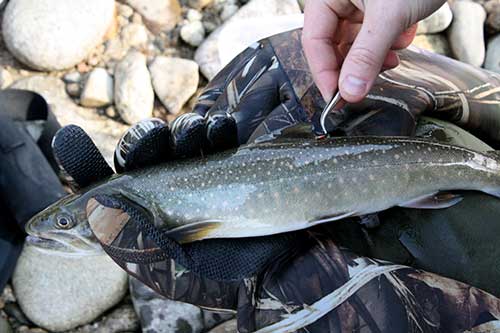- Reclamation
- Pacific Northwest Region
- Snake River Area Office
- ESA Activities
- Bull Trout
Bull Trout

As a result of declining populations of bull trout, the FWS listed bull trout in the Columbia and Klamath basins as threatened under the ESA in June 1998. On October 15, 1999 the FWS provided a Biological Opinion on Reclamation's Operations and Maintenance in the Snake River Basin above Lower Granite Reservoir.
This Opinion expired in 2004 and a new Opinion was issued in March 2005. Reclamation provided a Decision Document in November of 2005 as well as the final Monitoring and Implementation Plan in March of 2006.
In this new Opinion, the FWS concurred with Reclamation that the Operation and Maintenance of Arrowrock, Anderson Ranch, Deadwood and Agency Valley Dams may adversely affect bull trout. With more research completed on bull trout in these systems, a more in-depth Opinion was provided in 2005.
The 1999 Opinion listed reservoir drawdowns and entrainment (fish moving past dams) through the dams as conditions that cause adverse effects. The new Opinion added predation, decreased prey base, habitat degradation, disruption of migration cues, increased metabolic rates and decrease in growth rates as adverse effects. The FWS identified Terms and Conditions that Reclamation must follow to avoid the prohibitions of Section 9 (Take) of the Endangered Species Act. Those Terms and Conditions to minimize the take of bull trout are listed starting on page 258 of the Biological Opinion.
Transcript PDF 64 kb
Current Projects Associated with the Terms and Conditions in the Biological Opinion
 Boise Basin — Reclamation is investigating operational flexibility of pool elevation and maximum discharge at Arrowrock and Anderson Ranch reservoirs to reduce harm and harassment of Bull Trout in the Boise River Basin bull trout. Ramping rates will also be investigated at Anderson Ranch Dam. Spillway use will be minimized at both facilities to reduce bull trout entrainment. Reclamation works cooperatively with IDFG, USFS, and USFWS to study bull trout and bull trout habitat in the Boise River basin. As a requirement of the USFWS 2005 BiOp, Reclamation staff continues to trap and transport bull trout from Lucky Peak Reservoir back into Arrowrock Reservoir.
Boise Basin — Reclamation is investigating operational flexibility of pool elevation and maximum discharge at Arrowrock and Anderson Ranch reservoirs to reduce harm and harassment of Bull Trout in the Boise River Basin bull trout. Ramping rates will also be investigated at Anderson Ranch Dam. Spillway use will be minimized at both facilities to reduce bull trout entrainment. Reclamation works cooperatively with IDFG, USFS, and USFWS to study bull trout and bull trout habitat in the Boise River basin. As a requirement of the USFWS 2005 BiOp, Reclamation staff continues to trap and transport bull trout from Lucky Peak Reservoir back into Arrowrock Reservoir.
Payette Basin — Reclamation will continue to investigate the flexibility of discharge temperature, ramping rates and winter flows to increase downstream primary productivity and reduce harm and harassment of bull trout in the reservoir above and the river below Deadwood Dam. Spillway use will be avoided if possible. Biological and habitat data will be evaluated to predict if there is a better balanced flow regime for the system. As part of a cooperative agreement with the Boise National Forest, a radio telemetry investigation above and below the Deadwood Dam was initiated in 2005. This study will continue to investigate winter habitat use and entrainment of bull trout through the dam. Idaho Fish and Game will assist in downstream habitat studies as well as operating fish weirs on the mainstem Deadwood River, Trail Creek and Beaver Creek in the fall.
Malheur Basin — Reclamation staff continues working with the Burns Paiute Tribe, ODFW, USFS, and USGS to conduct bull trout life history studies in the North Fork Malheur River basin, including Beulah Reservoir. In 2003, Reclamation completed a Water Quality Modeling Study for Beulah Reservoir in an effort to determine the water quality parameters and minimum pool necessary to support a bull trout population. Ongoing work will include annual bull trout spawning surveys and trap and transport of bull trout back into Beulah Reservoir. Reclamation is also developing recommendations for minimum pool levels for maintaining a prey base for bull trout returning to the reservoir to overwinter. Spillway use will be minimized to reduce bull trout entrainment.
Related Links
Partners
- Rocky Mountain Research Station - USDA Forest Service
- Idaho Department of Fish and Game – Southwest Region
- USDA Forest Service – Boise National Forest
- Trout Unlimited – Ted Trueblood Chapter
- Trout Unlimited – Science Division
- Oregon Department of Fish and Wildlife
- Burns Paiute Tribe – Natural Resources
- USGS Idaho Water Science Center
- US Fish and Wildlife Service – Idaho Office
- US Fish and Wildlife Service – Oregon Office
Contact
Dmitri Vidergar
Fisheries Biologist
dvidergar.gov
(208) 383-2260

